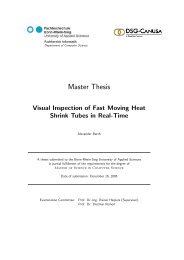Master Thesis - Hochschule Bonn-Rhein-Sieg
Master Thesis - Hochschule Bonn-Rhein-Sieg
Master Thesis - Hochschule Bonn-Rhein-Sieg
You also want an ePaper? Increase the reach of your titles
YUMPU automatically turns print PDFs into web optimized ePapers that Google loves.
5. Algorithms <strong>Master</strong> <strong>Thesis</strong> Björn Ostermann page 59 of 126<br />
5 Algorithms for robotic evasion<br />
Chapter 4 gives an overview on the flow of the data and the internal connection of the subparts and<br />
algorithms, which control the robot by analysis of the 3D images of the camera and the position<br />
information of the robot. To understand this project in total, a deeper view on the algorithms is<br />
necessary. Therefore the used algorithms are explained in this chapter in detail. Some algorithms have<br />
been developed in previous work [78], but only the depiction of the acquired information (see chapter<br />
5.1) could be reused without further improvement.<br />
5.1 Depicting the acquired information<br />
As described in chapter 4.3.1 it is necessary, to show the images and information acquired from the<br />
camera, in order to set up the workplace and explain the camera’s function during demonstrations.<br />
These algorithms are not necessary in the object avoidance process of the robot. The algorithms<br />
controlling the robot are designed to work with the unmodified data, delivered by the camera.<br />
Figure 37 shows two sample images, taken during operations.<br />
a) b)<br />
Figure 37: Sample images, taken in the workplace<br />
a) reflection image and b) distance image (see also Figure 21)<br />
The image data are acquired from the camera with the help of the C++ library supplied by the<br />
camera’s manufacturer (see chapter 3.4). The library’s function, responsible for the data acquisition,<br />
fills a prepared buffer variable in the developed program with an array of float numbers followed by<br />
an array of unsigned integer numbers. This process is described in detail in previous work [78].<br />
The float numbers represent the spherical distance data in meter, the integer values indicate the<br />
quantity of reflected light per pixel.<br />
To translate the spherical distance data into carthesian coordinates, the vectors of the respective pixels<br />
have to be used. This step is also achieved by a function supplied by the camera’s manufacturer. For<br />
demonstrative purposes it is sufficient to only display the carthesian value of the z-axis, the one














